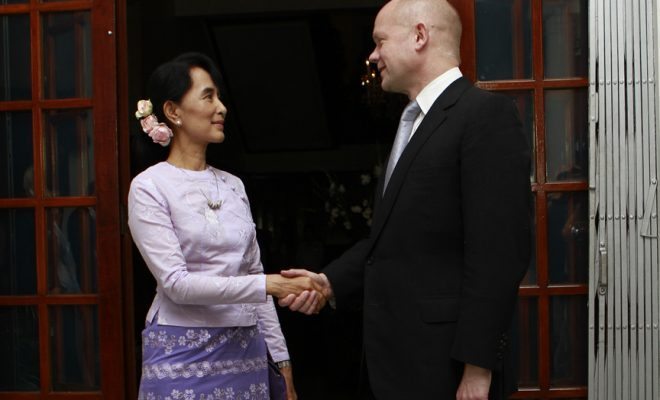 Image courtesy of [Foreign and Commonwealth Office via Flickr]
Image courtesy of [Foreign and Commonwealth Office via Flickr]
World
Myanmar or Burma: Conflict in a Country With Two Names
In a country where even the name is a contentious issue, Burma, or Myanmar as it has more recently been known, is home once again to a brewing conflict. There are many competing sides in this struggle, including the much-criticized government, the victimized Muslim population, and Buddhist monks who are advocating a nationalist message. The violence has already led to mass displacement, reprisal attacks and questions about Myanmar and its democratic reforms. A shaky government is gearing up for the 2015 elections, but the outcome of this conflict is anything but certain. Read on to learn about the history of Myanmar, the current conflict, and the prognosis.
What is Myanmar?
Myanmar, or Burma as it was known prior to 1989, is a country located in Southeast Asia. Its population of approximately 55 million people is comprised primarily of Burmese Buddhists, but there are also sizable minority groups residing there as well. For most of its history, Myanmar was home to independent Burmese kingdoms, until it was conquered and made a British colony from the nineteenth to twentieth centuries.
In 1937, Myanmar was finally separated from the British colony of India, and in 1948 gained full independence; however, independence did not exactly open the country to opportunity. Instead, for the next 60 or so years it was ruled by one military dictatorship after another. Finally, in 2011, a new quasi-civilian government was elected under the leadership of a man named Thein Sein and long-awaited reforms began. These reforms included releasing long-held political prisoners, agreeing to peace with minority groups, and opening up the press and the rest of society. The video below provides a description of the country’s road from independence to the present.
While the country stills struggles with violence and implementing reforms, its name also remains something of a quagmire. Although it officially changed the name from Burma to Myanmar following a brutal government crackdown in 1989, the world has been slow to accept it. The United States for example, while hopeful of Myanmar’s democratic aspirations, still officially uses the name Burma so as not to appear to sanction human rights violations there; however, during a historic visit in 2012, President Obama did refer to the nation as Myanmar instead of Burma. For the duration of this article, I will use Myanmar so as to avoid confusion.
A History of Conflict
Long before the invasion of colonizing British, Myanmar was home to extensive conflict. Much of the conflict was centered in a region called Rakhine, inhabited by the Rakhine people. The region has been repeatedly invaded by multiple forces. One of those forces is the minority Rohingya Muslim population, who clashed with the Buddhist Rakhine people. Rakhine has also been invaded by the Buddhist Burmese, who they are ethnically different from, mostly for political and historical reasons. Rakhine is a powder keg region that has consistently been a center of conflict in Myanmar.
There have also consistently been tensions between the Rohingya Muslims and the Buddhists (both Burmese and Rakhine). Some of it may stem from WWII, when Rohingya Muslims remained loyal to the British, while the Buddhists supported Japan in hopes of achieving independence. This was compounded after WWII when the Rohingya attempted to rise up and carve out an area of autonomy for themselves and were initially successful; however, over time they were defeated and have since been politically oppressed.
The Current Conflict
Rohingya Muslims
The Rohingya are a Muslim minority group in western Myanmar. The group are victims of an official government policy that has been called ethnic cleansing by some; their people are segregated into isolated camps and villages where basic services are not available. The situation is bad enough that the Rohingya are considered some of the world’s most persecuted people by the United Nations. In a recent national census the group was not even counted among the country’s citizens. In fact, a 1982 law forbids the Rohingya from becoming citizens of the country. The group is discriminated against both because of its religion and also its traditionally darker complexion.
The Rohingya originated from a part of what was once a region called Bengal and is now part of Bangladesh. While the Rakhine are the overall majority in the region, in the areas bordering Bangladesh, the Rohingya are actually the majority. It is still unclear exactly how the group came to the region, with some saying they have existed there for hundreds of years and others claiming they are relative newcomers from just this past century. Either way, the Rohingya are viewed with great hostility in Myanmar. This distinction also excludes them from indigenous status within the country’s constitution.
Rakhine Buddhists
The other group is the Rakhine Buddhist nationalists. Somewhat surprisingly, many of those involved in the conflict are also Buddhist monks. This movement has become known as the 969 movement.
The number 969 is a reference to Buddha and some of his teachings. The figurehead of this movement is Ashin Wirathu, who has risen to fame by delivering fierce speeches that include unsubstantiated claims about Muslims, calls to boycott Muslim businesses, and demands for laws that prevent interfaith marriage.
Nevertheless, while the Rakhine are the majority in the region, they are yet another minority within it. Unlike the Rohingya, who are generally viewed as newcomers, the Rakhine are a much older group there. In fact, they once had their own empire in what is now Bangladesh and Myanmar, before they were invaded by the Burmese. To the Rakhine and much of the rest of the population, the Rohingya therefore are an illegal immigrant group and are treated as such.
The Flashpoint
The current conflict was set off by the rape and murder of a Buddhist woman by a Muslim man in May 2012. This led to a wave of violence perpetrated primarily against Rohingya by Buddhist nationalists. A second wave of attacks took place that October. These were different from the first in two ways: first they were much more coordinated; second they were directed at Muslims in general and not just the Rohingya.
Following the attacks, the government took two steps. First it created an interfaith commission to provide a report on exactly what had led to the violence. While portions of the report were valuable, other parts that called for Rohingya family planning cast doubt on its goals. Second, as the focus of attacks grew from the Rohingya to Muslims in general, the government made an effort to protect Muslim populations by sending in police; however, far from being useful, police sometimes stood by or even engaged in violence against Muslims along with Buddhist nationalist crowds. The government also sent the army into areas and they have proven more effective because they have less Rakhine Buddhists among their ranks.
This conflict has led to terrible living conditions for the Rohingya, with many being forced to flee into Bangladesh where they are living in refugee camps. It has also led to a mass exodus as Muslim citizens of Myanmar seek safety in other countries. It has further led to several reprisal bombings and attacks on Buddhist holy sites and Myanmar government offices by Muslims who claim to be acting on behalf of the Rohingya. Domestically, it has increased scrutiny on a government seemingly unable to stop the violence. It has also opened the door to leadership for a the popular opposition candidate named Aung San Suu Kyi. The video below explains the conflict in depth.
The Future For Myanmar
Going forward, three groups of people are likely to have the biggest impact, not only on this conflict but on the country as a whole. These are the Myanmar government, politician Aung San Suu Kyi, and the Buddhist monk Ashin Wirathu
Myanmar Government
Aside from the Rakhine debacle, the government has several other things to worry about. According to international watchdog organization Human Rights Watch, the government has been backsliding on many of the promised reforms from 2011, namely granting freedom to the media. On top of this is the increasingly evident control still held by the military, which threatens to make the widely anticipated elections later this year into a farce that do nothing to change the status quo.
Unfortunately for the people of Myanmar the status quo is not that pretty either. The economy is one of the least advanced in the world. It is also plagued by sanctions from places like the U.S. and E.U. These conditions are only exacerbated by fighting and the perception of ethnic cleansing, which prevents new investments and global support.
Aung San Suu Kyi
Aside from the government’s inability to maintain control, it is also feeling heat from Aung San Suu Kyi. Kyi has been arrested a number of times for denouncing the military regimes that have ruled Myanmar over the course of the last 30 years. Her efforts even garnered her a Nobel Peace Prize in 1991.
Despite her record of denouncing injustice, however, she has declined to speak out in defense of the Rohingya. Many speculate this is her acting politically, as not only might she aspire to the presidency, but some of her strongest backers are the same Buddhist monks attacking Muslims. Furthermore it is unclear how much her voice could really alter things in Rakhine, especially considering the recent refusal by the government to allow her to run for the presidency. Still, it seems that as someone who champions civil rights she would stick up for a targeted minority even if it was unpopular, for the sake of country as a whole. Regardless of her relationship with the government, she is often viewed as a strong and respected voice in Myanmar. The video below chronicles Kyi and her viewpoints.
Ashin Wirathu
At the heart of Buddhist nationalist rhetoric is an embattled monk. Practically unknown before, he began to make a name for himself in 2001 during an earlier uprising against Muslims as part of the 969 group. His actions earned him 25 years in prison, but he was released as a political prisoner in 2010.
While he does not enjoy universal support, he has a large following because of his strong nationalist message and his denunciation of the Rohingya Muslims who are not liked by any segment of the population. Wirathu has also increased his audience by broadcasting on YouTube.
What gives him the most clout though is inaction. His fellow monks and the government have refused to discipline him. This has led some to believe he is preaching a message with which the government implicitly agrees. One of the few groups to oppose his teachings however, are certain women’s groups, which feel he labels the country with a bad image and is attempting to infringe on their rights by restricting who they can marry.
The following video details Wirathu and what he is preaching.
While these three actors are not the only ones at play in Myanmar, they are at the heart of the current conflict. They are also three agents who can affect change for good or for bad across the country itself.
Conclusion
The conflict in Myanmar threatens not just the Rohingya, but all minority groups. This is especially true in the wake of nationalist sermons preached by Buddhist Monks. Unfortunately not much is likely to be done about the situation. Although elections loom, the most promising candidate, Aung San Suu Kyi, is barred from participating. Unchecked and unresolved violence is only likely to simmer and burst out again; however, if the government can make real in-roads to reform and put on a legitimate election then the opportunity to rewrite Myanmar’s story still exists.
Resources
Primary
Additional
NPR: In Buddhist-Majority Myanmar, Muslim Minority Gets Pushed to the Margins
Washington Post: Why it’s Such a Big Deal That Obama Said ‘Myanmar’ Rather Than Burma
Al Jazeera America: Myanmar’s Buddhist Terrorism Problem
BBC: Why is There Communal Violence in Myanmar?
Human Rights Watch: Burma: Rights Heading in Wrong Direction
BBC News: Ashin Wirathu: Myanmar and Its Vitriolic Monk
International Crisis Group: The Dark Side of Transition: Violence Against Muslims in Myanmar
Quartz: Aung San Suu Kyi Has Gone Silent on a Major Human-Rights Crisis in Myanmar
Guardian: Burma Rules Out Lifting Ban on Aung San Suu Kyi Presidency Before Election








Comments